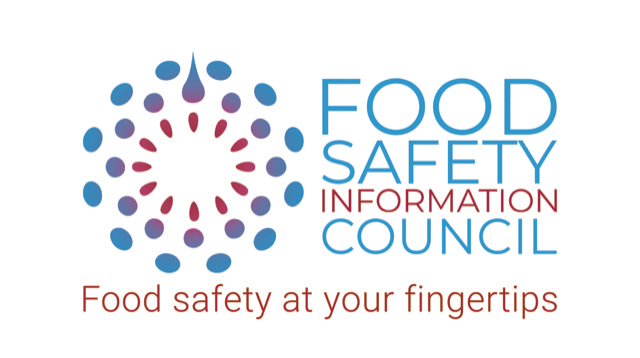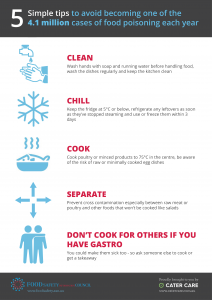Food Safety Myths Quiz printable version with answers
Q1. How often are you likely to get food poisoning?
a) Once every six months
b) Once a year
c) Once every five years
d) Once every ten years
Correct answer: c) Once every five years.
A study published in 2014 by the Australian National University found that there are an estimated 4.1 million cases of food poisoning each year which gives you an average chance of getting food poisoning once every five years. This is about the same as other developed countries such as the US, Canada or the UK.
Q2. If an egg has feathers and chicken poo on the shell does it mean it is:
a) Really fresh
b) Free range
c) A higher risk for causing food poisoning
Correct answer: c) A higher risk for causing food poisoning
Dirty eggs are more likely to have harmful bacteria such as Salmonella on them. OzFoodNet has shown that consumption of foods containing raw or minimally cooked eggs is currently the single largest cause of foodborne Salmonella outbreaks. This is particularly true for dishes containing uncooked or minimally cooked eggs such as eggnog, uncooked desserts such as mousses and tiramisu, hollandaise sauces, fresh mayonnaise, aioli, health shakes with added raw egg or steak tartar. In their most recent nine-year survey period they have linked 68 food poisoning outbreaks to eggs with 1404 Australians becoming ill, 322 hospitalised and 2 deaths. Salmonella can be present on the shells of any eggs and are not visible. Where chicken feathers or poo are visible there can be a greater chance of Salmonella present. It is illegal to sell cracked or dirty eggs. See our advice on egg safety
Q3. If you drop food on the floor it is ok to eat:
a) If you pick it up before 1 second
b) If you pick it up before 5 seconds
c) If you’ve dropped it on a smoothed tiled surface
d) It’s best not to eat at all
Correct answer: d) It’s best not to eat at all
Bacteria don’t politely wait 5 seconds to contaminate food dropped on the floor. Your floor will be contaminated from dirty shoes, by pets walking through and general day-to-day life. A preliminary UK study found fewer bacteria on carpets than smooth floor surfaces (but you don’t want to end up eating bits of carpet fluff on your food either).
Q4. If you’ve defrosted frozen meat or chicken can it be safely refrozen?
a) Yes
b) No
Correct answer: a) Yes
From a safety point of view it is fine to refreeze defrosted meat or chicken or any frozen food as long as it was defrosted in a fridge running at 5°C or below. You may have lost some quality in defrosting then refreezing as the cells break down a little and the food can become slightly watery. Another option is to cook the defrosted food and then divide into small portions and refreeze once it has stopped steaming.
Q5. If you want to refrigerate or freeze cooked leftovers you should divide them into small portions and:
a) Cool them to room temperature first
b) Wait until they stop steaming first
c) Put them straight into the fridge or freezer
Correct answer: b) Wait until they stop steaming first
Modern fridges can cope with warmer food being put in them so divide the cooked leftovers into smaller portions that will cool down quicker and refrigerate or freeze as soon as the food has stopped steaming.
Q6. Fridges will always stay at the same temperature:
a) True
b) False
Correct answer: b) False
While modern fridges keep their temperature better than earlier models did check with a fridge thermometer that your fridge is running at 5°C or below, especially when the weather starts warming up. If you are entertaining put the drinks on ice and use the fridge for the food, this will stop the fridge door being opened more than it needs to. See more on fridge safety
Q7. Hamburgers can be served rare:
a) True
b) False
Correct answer: b) False
Always cooked minced meat products such as hamburgers and sausages until they are 75°C inside because bacteria on the outside of pieces of meat can be transferred throughout the meat when it is minced. See more on meat safety
Q8. Pork must always be cooked all the way through:
a) True
b) False
Correct answer: b) False
Like beef or lamb, you can safely serve whole pieces of pork rare safely in Australia as the type of parasites (e.g. Trichinella) that may be a concern in pig meat overseas are not present in Australia’s commercial pig population. Minced pork products or rolled and/or stuffed cuts such as roasts and schnitzels must be cooked to 75°C at the centre.
Q9. You can tell if food is contaminated because it smells or tastes ‘off’:
a) True
b) False
Correct answer: b) False
You can get food poisoning from food that smells and tastes great. Bacteria can grow quickly in food that has been left in the temperature danger zone between 5°C and 65°C C with no change in the food’s smell or appearance. When food smells “off” it is usually due to spoilage bacteria growing and they may not make you sick.
Q10. If I get food poisoning it is most likely to be from the last meal I ate.
a) True
b) False
Correct answer: b) False
Everyone blames their food poisoning on the last meal they ate but some forms of food poisoning can take days or even weeks to eventuate. This is what makes it very difficult sometimes for health professionals to find what causes food poisoning.
Q.11 Food poisoning can cause:
a) Vomiting
b) Diarrhoea
c) Reactive arthritis
d) Kidney damage
e) Nerve damage
f) Hepatitis
g) Death
h) All of the above
Correct answer: h) All of the above
While vomiting and diarrhea are the most common symptoms, food poisoning in extreme forms can cause many symptoms including all of those above. Each year food poisoning results in 31,920 hospitalisations, 86 deaths and 1 million visits to doctors.
Q.12 If you are a vegetarian, your risk of food poisoning is low?
a) True
b) False
Correct answer: b) False
Sorry vegetarians, but many food poisoning outbreaks have been caused by improper handling of fruit and vegetable food items such as frozen berries, semi dried tomatoes orange juice, cooked rice, bean or alfalfa sprouts.
Q.13 How do you know when minced meat or chicken is cooked safely?
a) By tasting it
b) Using a thermometer to check it has reached 75°C
c) Checking meat juices aren’t pink
d) All of the above
Correct answer: b) Using a thermometer to check it has reached 75°C
A thermometer is the only way to know your food is cooked correctly to an internal 75°C.
Q14. Which of the following types of food are likely to cause food poisoning if cooked or stored incorrectly?
a) Raw egg dishes
b) Chicken
c) Minced meat
d) Bean or seed sprouts (eg alfalfa sprouts)
e) Seafood
f) Cooked rice
g) All of the above
Correct answer: g) All of the above
Seafood in Australia is very safe but can be a culprit due to toxins. OzFoodNet has determined that poultry is the primary source of Campylobacter outbreaks in Australia and the increase in Salmonella infections in recent years are linked to raw or minimally cooked egg dishes. Most people don’t recognize seed sprouts as a risk- a 2005 Salmonella outbreak in WA of 125 cases and a 2006 Salmonella outbreak of 15 cases in Victoria were both linked to alfalfa sprouts. Most people are surprised that cooked rice is a food poisoning risk. Once it is cooked and begins to cool then toxins can be formed by Bacillus cereus. This bacterium can form heat resistant spores and a heat resistant toxin. If cooked food is allowed to cool slowly the spores can germinate and reheating or lightly cooking the food will not destroy this toxin.
Q15. A ‘Use by’ date on a packaged food means:
a) You must use it by that date or you may get sick
b) You can still eat it after that date but it may have lost some nutrition or quality
Correct answer: a) You must use it by that date or you may get sick
Not surprisingly a ‘use by’ date means exactly that: you must use or freeze the food by that date or you may get sick. A ‘best before’ date on a packaged food means that you can still eat it after that date but it may have lost some nutrition or quality.
Q16. Unpasteurised (raw) milk is
a) Good for you as it has more vitamins
b) Healthier as it has good bacteria
c) Riskier as it can be contaminated with harmful bacteria
Correct answer: c) Riskier as it can be contaminated with harmful bacteria
Pasteurisation (heat treatment for a short period to kill harmful bacteria) has done a great deal to reduce food borne disease over the years. It is illegal to sell unpasteurised (raw) cow’s milk in Australia for human consumption and health authorities recommend that it should not be consumed. No matter how carefully the animals are milked there is always a risk of harmful bacterial being present. Consuming raw milk can cause severe illness due to the possible presence of harmful bacteria such as Shiga Toxin–Producing Escherichia coli, Campylobacter and Salmonella. Pregnant women, young children (particularly babies), the elderly, and people with weakened immune systems are at greatest risk of getting sick and the consequences for them can be more severe. Pasteurised milk is as nutritious as unpasteurised milk.

